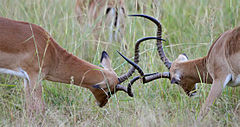Our website is made possible by displaying online advertisements to our visitors.
Please consider supporting us by disabling your ad blocker.
Rut (mammalian reproduction)
The examples and perspective in this article may not represent a worldwide view of the subject. (December 2023) |

The rut (from the Latin rugire, meaning "to roar") is the mating season of certain mammals, which includes ruminants such as deer, sheep, camels, goats, pronghorns, bison, giraffes and antelopes, and extends to others such as skunks and elephants. The rut is characterized in males by an increase in testosterone, exaggerated sexual dimorphisms, increased aggression, and increased interest in females.[1] The males of the species may mark themselves with mud, undergo physiological changes or perform characteristic displays in order to make themselves more visually appealing to the females.[1][2] Males also use olfaction to entice females to mate using secretions from glands and soaking in their own urine.[1][3][4] Deer will also leave their own personal scent marking around by urinating down their own legs with the urine soaking the hair that covers their tarsal glands. Male deer do these most often during breeding season.[citation needed]
During the rut (known as the rutting period and in domestic sheep management as tupping), males often rub their antlers or horns on trees or shrubs, fight with each other, wallow in mud or dust, self-anoint, and herd estrus females together. These displays make the male conspicuous and aid in mate selection.
The rut in many species is triggered by shorter day lengths. For different species, the timing of the rut depends on the length of the gestation period (pregnancy), usually occurring so the young are born in the spring. This is shortly after new green growth has appeared thereby providing food for the females, allowing them to provide milk for the young, and when the temperatures are warm enough to reduce the risk of young becoming hypothermic.
- ^ a b c Poole, Joyce (September 1987). "Rutting Behaviour in African Elephants: The Phenomenon of Musth". Behaviour. 102 (3): 283–316. doi:10.1163/156853986x00171.
- ^ Lincoln, G.A. (1971). "The seasonal reproductive changes in red deer stags". Journal of Zoology. 163: 105–123. doi:10.1111/j.1469-7998.1971.tb04527.x.
- ^ Geist, Valerius (1964). "On the Rutting Behavior of the Mountain Goat". Journal of Mammalogy. 45 (4): 551–568. doi:10.2307/1377327. JSTOR 1377327.
- ^ Cite error: The named reference
:1was invoked but never defined (see the help page).
Previous Page Next Page


